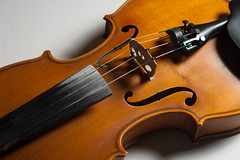The earliest stringed instruments were mostly plucked (e.g. the Greek lyre), says Wikipedia.
Bowed instruments may have originated in the equestrian cultures of Central Asia, an example being the Kobyz, an ancient Turkic, Kazakh or Mongolian instrument.
Turkic and Mongolian horsemen from Inner Asia were probably the world’s earliest fiddlers. Their two-stringed upright fiddles were strung with horsehair strings, played with horsehair bows, and often feature a carved horse’s head at the end of the neck.
The violins, violas, and cellos we play today, and whose bows are still strung with horsehair, are a legacy of the nomads.[3]
It is believed that these instruments eventually spread to China, India, the Byzantine Empire and the Middle East. The violin in its present form emerged in early 16th-Century Northern Italy, where the port towns of Venice and Genoa maintained extensive ties to central Asia through the trade routes of the silk road.
The word violin comes from the Middle Latin word vitula, meaning stringed instrument;[1] this word is also believed to be the source of the Germanic "fiddle".[2]
Antonio Stradivari (1644 – 1737) was an Italian luthier, a crafter of stringed instruments such as violins, cellos, guitars, violas, and harps, says Wkikpedia.
Stradivari is generally considered the most significant artisan in this field. The Latinized form of his surname, Stradivarius, as well as the colloquial, "Strad", is often used to refer to his instruments. It is estimated that he made 1,000 to 1,100[1][2] instruments and that around 650 of these instruments have survived[3] including 450[1] to 512[2] violins.
- Cremona, Italy, in the Po River valley,
- spruce, willow, maple woods with treatment in borax, sodium & potassium silicate.
- varnish of gum arabic, honey & egg white.
- family business.
Subscribe to:
Post Comments (Atom)





No comments:
Post a Comment